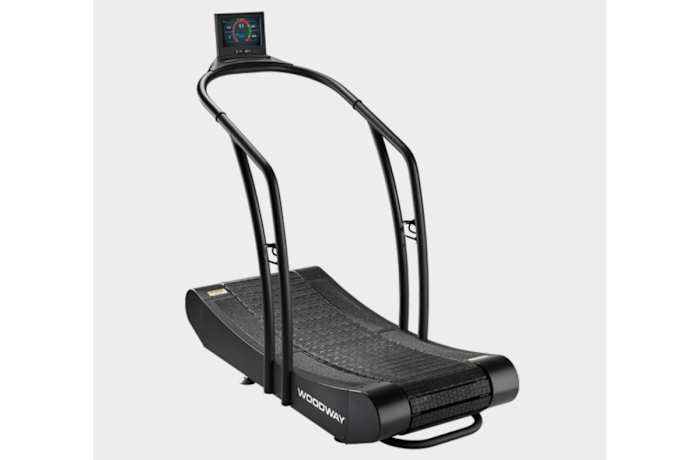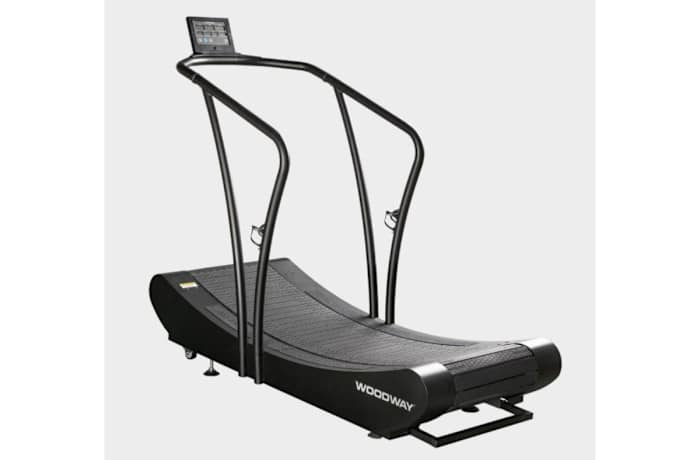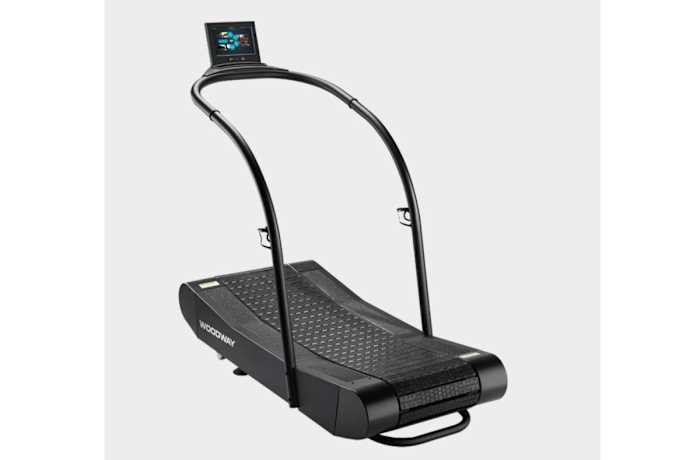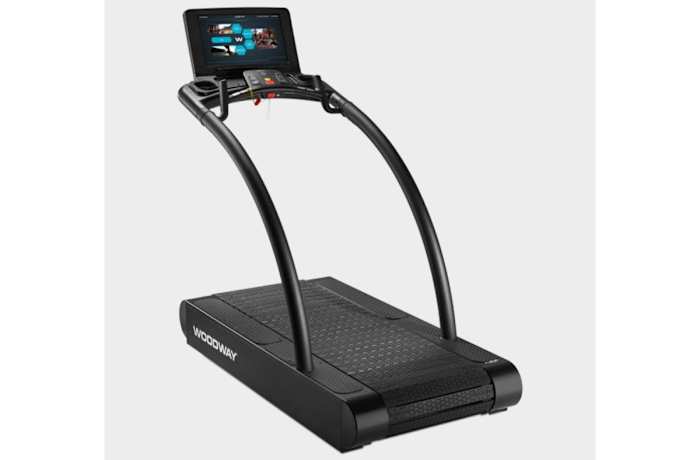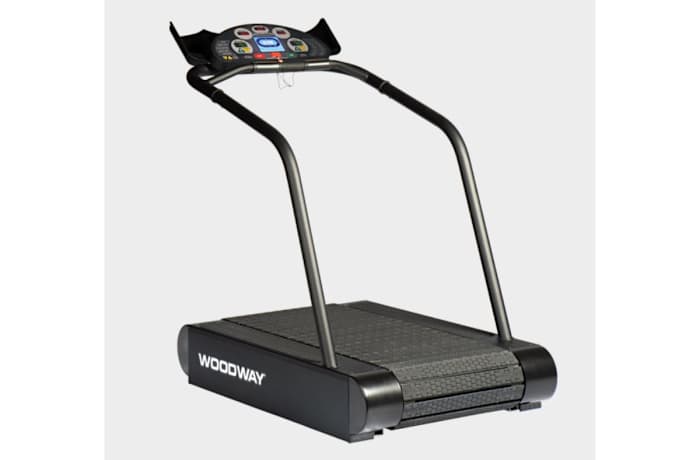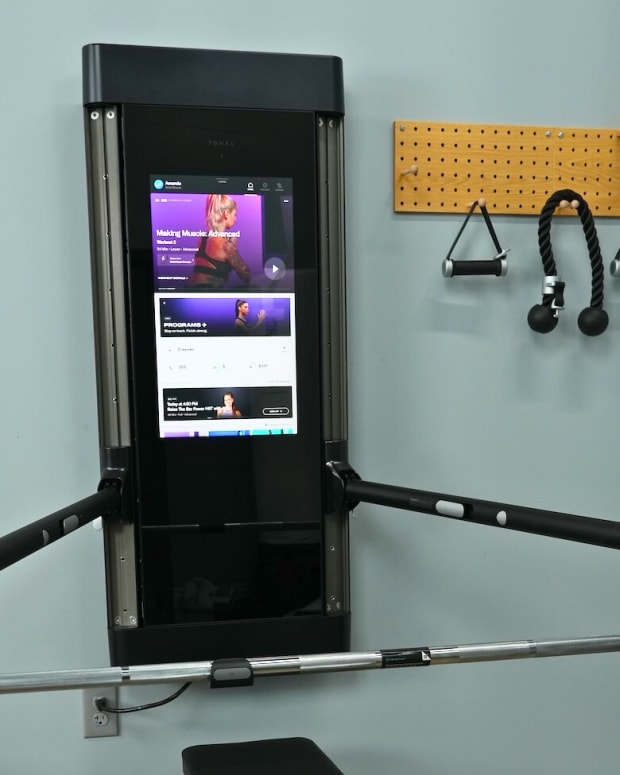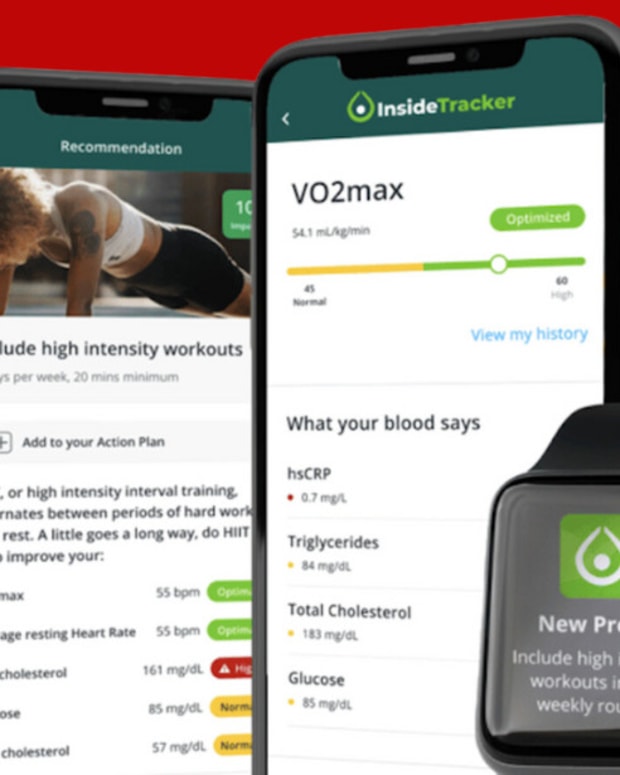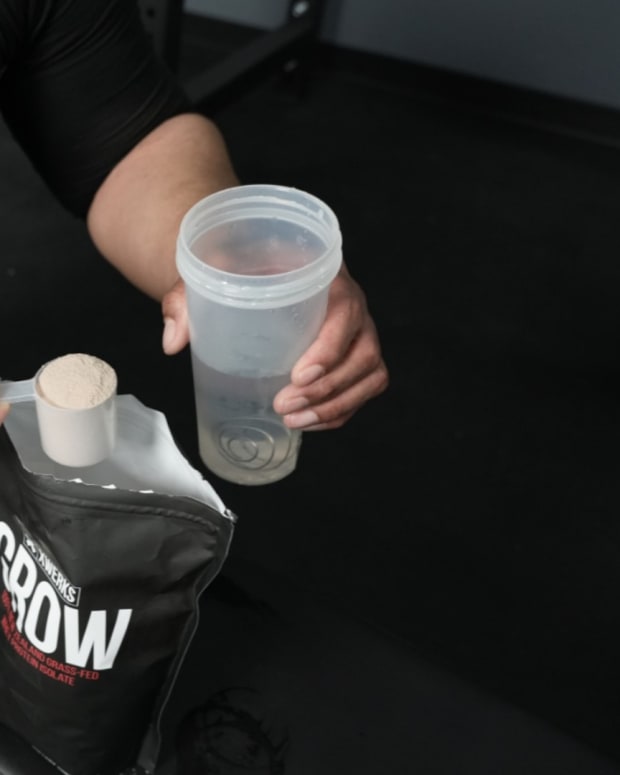The products featured in this article have been independently reviewed. When you buy something through the retail links on this page, we may earn commission at no cost to you, the reader. Sports Illustrated editorial staff are not involved in the creation of this content. Learn more here.
Running in place has gotten a whole lot more interesting as treadmills evolve to include technological advancements like smart coaching, streaming capabilities and connected classes. But ask any pro athlete or scope out the machines at a high-end commercial gym, and one brand in particular stands out: Woodway.
Woodway’s treadmills use a unique, slatted rubber surface that puts less stress on your joints—a huge selling point for fans of a sport that’s known for its repetitiveness (FYI: just one 10-minute mile consists of roughly 1,700 steps). Woodway is also well-known for their curved, manual treadmills, which are entirely human-powered and allow for instantaneous speed adjustments and more dynamic training.
If you’re looking to take your performance to the next level in 2024 (and have the budget to really splurge), these are the top five Woodway treadmill picks—plus a comprehensive guide on how to choose the best Woodway treadmill for you, how Woodway treadmills compare to the competition and what you should consider before buying.
Our Picks for the Best Woodway Treadmills of 2024:
Woodway Curve Treadmill
Key features and specs:
- Touchscreen with standard display options
- Weight capacity of 400 pounds for running and 800 pounds for walking
- Belt footprint of 67-inches L x 17-inches W
- Machine footprint of 67-inches L x 33-inches W x 67-inches H
- Costs $5,995
Woodway is known for its curved treadmills, and for good reason: This type of machine’s belt—made from near frictionless rubber slats—is powered by the user’s effort, which means there’s no speed limit, and you’re not subjected to the lagging ramp up/down speeds during intervals that you might experience on a traditional treadmill. The payoff? The transitions in high-intensity interval training are a breeze. And because there’s no motor, a manual tread is quieter and requires less maintenance. Woodway says it can handle up to 150,000 miles before the slatted belt and deck may need some TLC.
Pros:
- Curved shape engages more muscles and encourages proper form
- Wireless heart rate monitoring capabilities
- Thick rubber slats provide extra cushioning for joints
Cons:
- Very expensive
- 17-inch running belt width may feel cramped for some users
- Difficult to move, since it weighs 350 pounds
Woodway Curve XL Treadmill
Key features and specs:
- Standard display screen
- Weight capacity of 400 pounds for running and 800 pounds for walking
- Belt footprint of 86-inches L x 22-inches W
- Machine footprint of 86-inches L x 38-inches W x 75-inches H
- Costs $10,500
Not all runners look like Eliud Kipchoge or Sara Hall. Larger athletes who use high-intensity interval training to supplement basketball or football training and love the self-powered nature of the Woodway Curve will appreciate the XL, which has a belt that’s 19 inches longer and five inches wider than the original machine. This machine is recommended for users over six feet, five inches; otherwise, the XL uses the same shock-absorbing rubber and five percent curve as its smaller sister. If you’ve ever felt like your gait has been compromised while running on a treadmill that feels just a little bit too small, you’ll want to upgrade to the XL.
Pros:
- Accommodates larger runners
- Vulcanized rubber slats last 10 times longer than the average treadmill belt
Cons:
- Huge footprint
- Very difficult to move, since it weighs 550 pounds
- No incline or decline options
Woodway Curve Trainer Treadmill
Key features and specs:
- Touchscreen with standard display options
- Weight capacity of 400 pounds for running and 800 pounds for walking
- Belt footprint of 67-inches L x 17-inches W
- Machine footprint of 67-inches L x 33-inches W x 67-inches H
- Costs $4,995
If this looks familiar, that’s to be expected—the Curve Trainer is another variation on the OG Curve Treadmill. While the original is excellent for high-intensity interval training, this one has a slightly flatter base designed to appeal to walkers and joggers looking to improve their endurance. With a three percent curve instead of five percent, you’ll still get the muscle engagement and form encouragement of the concave shape, but it will be easier to maintain your effort over long runs—which will eventually increase your stamina.
Pros:
- Slightly flatter base than the original Curve treadmill
- Designed for longer duration walks and runs
- Has built-in wheels and a lift bar so you can tilt and roll it when necessary
Cons:
- 17-inch running belt width may feel cramped for some users
- Difficult to move, since it weighs 350 pounds
Woodway 4Front Treadmill
Key features and specs:
- Max speed of 12.5 miles per hour
- Zero to 15 percent incline
- Belt footprint of 68-inches L x 22-inches W
- Machine footprint of 72-inches L x 35-inches W x 64-inches H
- Costs $13,995
Woodway was the first to introduce the slat-belt design—a contrast to the traditional conveyor belt style—to flat, motorized treadmills, and it’s still being used in the 4Front 40 years later. The slats are made from vulcanized rubber, which is ultra durable and gentler on your joints. You can use three different training modes on the 4Front: traditional; dynamic, which allows you to power the belt like a manual treadmill; and resistance, which allows you to set different levels of resistance for interval training. Pair it with the ProSmart Touchscreen, which creates customized workouts based on your goals and streams runs in real world or virtual environments.
Pros:
- Four display options offered
- Use Apple Watch to connect to Apple Gymkit, or pair with other popular runnings apps
- Uses 50 percent less electricity compared to a normal treadmill
Cons:
- Very expensive
- ProSmart Cloud Services Fee costs an additional $180/year
Woodway Path Treadmill
Key features and specs:
- Max speed of 11 miles per hour
- Zero to 15 percent incline
- Belt footprint of 52-inches L x 22-inches W
- Machine footprint of 59-inches L x 35-inches W x 60-inches H
- Costs $8,995
While it’s not quite a compact treadmill (it doesn’t fold, and it still weighs 405 pounds), the flat Path treadmill is Woodway’s smallest footprint motorized treadmill. The Path’s belt is 15 inches shorter than the belts on most of the company’s treads, but at 52 inches long, it’s still close enough to the industry standard to work for most runners. It’ll save you floor space without sacrificing the shock-absorption benefits of the slatted belt design—and it’s near silent (the motor uses 50 percent less electricity than a normal treadmill), making it ideal for smaller spaces.
Pros:
- Three display options offered
- More compact than other Woodway treadmills
- Wider belt accommodates more runners
Cons:
- Shorter length may not work for taller runners
- Does not pair with ProSmart screen
Benefits of Using a Treadmill
Treadmills may get a bad rap (running outdoors is inherently more exciting than running in place), but there are some solid benefits to treadmill running. For starters, a treadmill allows you to completely control your environment: pace, incline, intervals, etc.; not only does that negate weather or location issues, but it can help teach you what certain speeds and efforts feel like, which will translate to running outside (if you want to do that).
Running on a cushioned belt can be more forgiving on weight-bearing joints like the ankles, knees and hips than hard concrete or pavement. Treadmill runners tend to have shorter stride lengths and higher stride rates on a treadmill than when running outside, according to a 2014 review, which also translates to less impact on those joints.
And, for the record, your biomechanical patterns (natural movement patterns) don’t change when running on a treadmill versus when running outside, according to older research published in the journal Medicine & Science in Sports & Exercise. Your VO2 max—how much oxygen your body can use during physical activity and a benchmark for cardiovascular fitness—is also the same when running on a tread compared to outside, a study published in that same journal determined.
How to Choose the Right Woodway Treadmill For You
Manual vs. electric
You’re likely most familiar with an electric or motorized treadmill, which uses a motor to engage the belt. The average motor size on a home treadmill is 2.5 horsepower. The bigger the motor, the more powerful the machine; heavier users or users who run at very fast speeds will want a bigger motor.
A manual treadmill is one powered by your effort. Translation: The belt only moves if you move it. This can increase your heart rate and calorie burn, because you have to work harder to overcome the resistance of the treadmill belt. But manual treadmills tend to have less bells and whistles than electric ones.
Running deck shape
Most treadmills designed for home use have a traditional flat belt. This flat belt can be raised or lowered, but the path itself has no curve, tilt or angles. Setting a flat treadmill to a one percent grade may better simulate the experience of running outdoors, but only if you’re running a 7:09 pace or faster, according to research from the Journal of Sports Sciences.
A curved treadmill is one that (surprise!) has a concave, U-shaped running surface and is powered by your stride, not a motor. A curved treadmill leads to greater metabolic intensity and higher rates of perceived exertion, but people generally preferred to run slower on curved treadmills as a result, a study published in Physical Therapy in Sport found.
Incline
Adjusting the incline on a treadmill to simulate hills can force your body to work harder and engage different muscles as you fight against the resistance of gravity. Most treadmills have incline settings anywhere from 0.5 percent to 15 percent; some newer treadmills offer inclines all the way up to 40 percent, and others even offer a decline option to simulate downhills. Most indoor runners will do just fine with a treadmill that maxes out at 10 percent.
Speed
Treadmill speeds are generally measured in miles per hour (mph). For example, a 6.0 speed on a tread converts to a 10:00/mile pace. The higher the number, the faster the belt of the treadmill goes. Entry-level treadmills go up to eight to 10 miles per hour, while higher-end at-home treads max out at 12 or 12.5 miles per hour. The most intense treadmills (usually reserved for pro athletes) can reach speeds up to 25 miles per hour.
Related Post: Best Pedometers for Counting Your Steps
Size
Treadmills are not small machines, so it’s important to make sure you have the space for one. Woodway treadmills do tend to be bulkier than more affordable options. Not only do you need the available floor space to fit the machine, but you should leave ample room behind, to the sides and above the tread, so you don’t compromise your running mechanics in any way.
Display
Woodway offers a number of display options. The standard display tracks speed, distance, time, watts, laps and heart rate. The Quick Set LED display also has speed, elevation and stop controls and Bluetooth capabilities. The 4Front View also has Bluetooth capabilities, as well as an embedded 19-inch LCD HDTV. The Personal Trainer Display uses a color LCD screen, has Bluetooth capabilities, 10 pre-programmed workouts and the ability to create up to 99 custom user workouts. And the ProSmart Touchscreen offers smart coaching, entertainment options, customizable workouts and browsing and streaming capabilities. Make sure to check which screens are compatible with a device before you buy.
Metrics
Even Woodway’s most basic machine will track pace, watts, laps, heart rate, time, calories, distance and METs (AKA the metabolic equivalent for task).
Price
A treadmill is expensive. A Woodway treadmill is exceptionally expensive. But the durability and lower operating costs of a Woodway do make it a worthwhile investment compared to some of the more affordable options. If you invest in a Woodway, chances are, you’ll have it for life.
Woodway Treadmill FAQs
Are curved treadmills better?
A curved treadmill isn’t necessarily better for you, but you will work harder on one. Runners worked about 30 percent harder on curved, non-motorized treadmills compared to a standard motorized treadmill set to a one percent gradient, according to a 2018 study published in the Journal of Science and Medicine in Sport. But, as noted in research cited above, curved treadmills generally lead to a significantly slower preferred pace, which may offset some of those benefits. The best treadmill for you is the one you’re going to use most consistently.
How much do Woodway treadmills weigh?
The Woodway treadmills featured here weigh between 350 and 550 pounds. The Curve, Curve XL and Curve Trainer all come with built-in wheels and a lift bar so you can tilt and roll them when necessary.
How long do Woodway treadmills last?
The running surface on Woodway treadmills lasts for more than 150,000 miles, about ten times longer than the belt of an average treadmill. The company offers a five-year warranty on the frame, drive, motor and belt; a three-year warranty on all components; and a one-year warranty on labor.
Are Woodway treadmills better for walking or running?
Woodway treadmills are great for walking and running. The curved, non-motorized treadmills are manually powered, which allows you to customize your workout no matter your fitness level. The longer your strides, the more the belt speed increases; if you slow down, it slows down. Whether you’re running or walking on the treadmill, the natural curve reinforces proper running form and increases muscle activation in your glutes, calves and hamstrings. Woodway’s treadmills have a weight capacity of 400 pounds for running and 800 pounds for walking.
What is special about Woodway treadmills?
Woodway introduced the slat-belt treadmill design, which reduces shock and increases comfort—protecting your joints—during your workouts. That design makes them more durable. The vulcanized rubber surface lasts significantly longer than a traditional treadmill belt and requires almost no maintenance. The curved treadmills are non-motorized, which requires no electricity, and the motorized options use about 50 percent less electricity to operate than a normal treadmill.
Final Thoughts
Woodway treadmills have been around for over four decades, and their slatted design—with its durable rubber and shock absorbing capabilities—helps keep people healthier, whether they’re walking, running or rehabilitating post-injury. They’re certainly an investment, and one that’s not necessarily realistic for many people, but for anyone who’s committed to leveling up their fitness and has the budget, the investment should pay off in the long run.
Prices are accurate and items in stock as of publish time.

